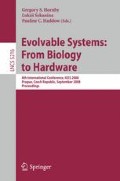Abstract
The ubichip is a reconfigurable digital circuit with special reconfiguration mechanisms, such as dynamic routing and self-replication, for supporting the implementation of bio-inspired hardware systems. The dynamic routing mechanism allows to create and destroy interconnections between remote units in a distributed fashion, thus proving useful for implementing cellular systems featuring dynamic topologies. Evolutionary graph theory investigates genetic and cultural evolution processes using the mathematical formalism of both evolutionary game and graph theory. Populations are embedded in graphs representing interaction and imitation links. Payoffs are assigned and successful individuals are imitated with high probability. This paper describes the hardware implementation of a general evolutionary graph model in which the imitation network changes over time by exploiting the dynamic routing capabilities of the ubichip. As a particular example, we analyze the case of a coordination game played by agents arranged in a cycle in which imitation links are randomly created so as to simulate dynamic small-world networks.
Access this chapter
Tax calculation will be finalised at checkout
Purchases are for personal use only
Preview
Unable to display preview. Download preview PDF.
References
Sanchez, E., Perez-Uribe, A., Upegui, A., Thoma, Y., Moreno, J., Villa, A., Volken, H., Napieralski, A., Sassatelli, G., Lavarec, E.: PERPLEXUS: Pervasive computing framework for modeling complex virtually-unbounded systems. In: Arslan, T., et al. (eds.) AHS 2007 - Proceedings of the 2nd NASA/ESA Conference on Adaptive Hardware and Systems, pp. 587–591. IEEE Computer Society Press, Los Alamitos (2007)
Upegui, A., Thoma, Y., Sanchez, E., Perez-Uribe, A., Moreno, J.M., Madrenas, J.: The Perplexus bio-inspired reconfigurable circuit. In: Arslan, T., et al. (eds.) Proceedings of the 2nd NASA/ESA Conference on Adaptive Hardware and Systems, pp. 600–605. IEEE Computer Society Press, Los Alamitos (2007)
Upegui, A., Thoma, Y., Perez-Uribe, A., Sanchez, E.: Dynamic routing on the ubichip: Toward synaptogenetic neural networks. In: AHS 2008 - Proceedings of the 3rd NASA/ESA Conference on Adaptive Hardware and Systems, pp. 228–235. IEEE Computer Society Press, Los Alamitos (2008)
Gintis, H.: Game theory evolving. Princeton University Press, Princeton (2000)
Maynard Smith, J.: Evolution and the Theory of Games. Cambridge Univ. Press, Cambridge (1982)
Boyd, R., Richerson, P.J.: Culture and the evolutionary process. University of Chicago Press, Chicago (1985)
Szabo, G., Fath, G.: Evolutionary games on graphs. Physics Reports 446(4-6), 97–216 (2007)
Nowak, M.A., May, R.M.: Evolutionary games and spatial chaos. Nature 359(6398), 826–829 (1992)
Thoma, Y., Upegui, A., Perez-Uribe, A., Sanchez, E.: Self-replication mechanism by means of self-reconfiguration. In: Platzner, M., Grosspietsch, K.E., Hochberger, C., Koch, A. (eds.) ARCS 2007. LNCS, vol. 4415, pp. 105–112. Springer, Heidelberg (2007)
Thoma, Y., Sanchez, E.: An adaptive FPGA and its distributed routing. In: Proc. ReCoSoc 2005 Reconfigurable Communication-centric SoC, Montpellier - France, June 2005, pp. 43–51 (2005)
Ohtsuki, H., Pacheco, J.M., Nowak, M.A.: Evolutionary graph theory: Breaking the symmetry between interaction and replacement. Journal of Theoretical Biology 246(4), 681–694 (2007)
Thoma, Y., Upegui, A.: Ubimanager: a software tool for managing ubichips. In: AHS 2008 - Proceedings of the 3rd NASA/ESA Conference on Adaptive Hardware and Systems, pp. 213–219. IEEE Computer Society Press, Los Alamitos (2008)
Author information
Authors and Affiliations
Editor information
Editors and Affiliations
Rights and permissions
Copyright information
© 2008 Springer-Verlag Berlin Heidelberg
About this paper
Cite this paper
Peña, J.C., Peña, J., Upegui, A. (2008). Evolutionary Graph Models with Dynamic Topologies on the Ubichip. In: Hornby, G.S., Sekanina, L., Haddow, P.C. (eds) Evolvable Systems: From Biology to Hardware. ICES 2008. Lecture Notes in Computer Science, vol 5216. Springer, Berlin, Heidelberg. https://doi.org/10.1007/978-3-540-85857-7_6
Download citation
DOI: https://doi.org/10.1007/978-3-540-85857-7_6
Publisher Name: Springer, Berlin, Heidelberg
Print ISBN: 978-3-540-85856-0
Online ISBN: 978-3-540-85857-7
eBook Packages: Computer ScienceComputer Science (R0)

